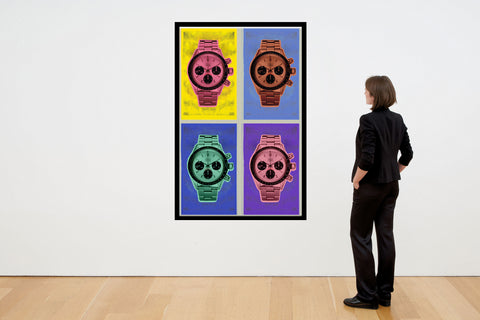
Interview: Ed Tsuwaki
By Jens Jensen
Perhaps best known for his poetic and feminine illustrations of female models with big eyes and long necks, Ed Tsuwaki has worked with everything from lingerie and cosmetics to hard cider. He was an early adopter of digital technology and remembers buying the first colour Mac IICi back in 1990 with a five-year JP¥ 2 million loan. In the 1990s, he worked mainly as an art director, designing CD and record covers (music has always been a big inspiration to him) and in 1996 made his international debut with a five-page story in the French magazine CitizenK. That lead to other international work for magazines such as Elle, Marie Claire, Wallpaper*, and Vogue, and when Vogue decided to launch in Japan in 1999, Ed made a splash with an illustrated story of how Audrey Hepburn might have dressed that year, making him a household name within the industry both locally and abroad.
Besides illustrations, he also does more personal paintings and even ceramics, but after much soul-searching is most comfortable with the rather unpretentious title of illustrator. “I like the challenge of working within a set of predefined parameters”, he explains as he shows us around his bright and spacious home and studio in Tokyo.

Tsuwaki on the balcony of his home in Tokyo.
ACM: You were born and raised in Hiroshima. What did you do for fun as a child?
ET: I’ve always loved drawing. As well as that, I became obsessed with making plastic models of cars when I was in primary school. I would paint the body and even the windows and frames, so that’s how I got my paintbrush skills. I also did a lot of fishing and insect collecting. In junior high school, I started listening to music and, in high school, I became interested in fashion.
[When I was a child], many American families were living in my neighbourhood. By the time I was a teenager, they had all gone home. In retrospect, I think that many of them were research scientists related to the atomic bombing. I was born in 1966, only 20 years after the atomic bomb was dropped on Hiroshima. The city had been completely cleaned up and almost all traces of the bomb had disappeared.
Your career started with live painting and club exhibitions. How did it all begin?
In junior high school, I became quite obsessed with music. One of my favourite bands was the Yellow Magic Orchestra (YMO) and, when I was 14 years old, they were going to play in Hiroshima. I was too scared to go on my own, but was impressed by their visuals and the sound. I immediately bought the album Solid State Survivor and listened to it every day.


Tsuwaki's interest in art spans many years and various approaches.
After that, I started to collect records whenever I had the money, so I would say that one of the art mediums that directly influenced me was the artwork on record covers.
The first painting I saw in a museum was by Léonard [Tsuguharu] Foujita, in 1987. I was already living in Tokyo at the time, but when I went back home I saw it at the Hiroshima Prefectural Museum of Art. That was also an early source of inspiration.
Did you ever formally study illustration or art?
I never went to art school, but I have been drawing every day since I was a child, so my skills have just slowly developed. I’m still learning every day now. It’s funny – I often get asked if I studied art, but normally you wouldn’t ask a novelist or a [musician] where he learned to write or play music. I think where you were born and how you spent your childhood has a more prominent influence on what you do later in life.

Tsuwaki surrounded by some of his artwork – trademark illustrations of women with big eyes and long necks.
You moved to Tokyo after graduating high school. What attracted you to the big city?
I moved to Tokyo in the spring of 1985. I was super interested in music artwork, fashion and various Tokyo subcultures. I knew that what I wanted to do was to be an illustrator or art director when I was in high school and because all of this was coming [out of] Tokyo, I had a strong desire to be there and be close to what I loved. My parents didn’t really approve of my drawings and my dreams, so I told them I wanted to go to university in Tokyo and they agreed to let me go to a prep school with a dorm in the city. I spent all the time drawing and painting. Didn’t study at all.
After a year I told my parents what I had been up to and they were naturally quite surprised. So, I betrayed my parents and did things my way, but – I don’t know – the thrill of it made me push myself harder. Also, because I had a time limit, I had to produce results quickly. Someone at university has four years to prepare for real life, but I had made my professional debut by that time. Not that I knew much back then.
It seems that many artists in Japan work both with fine art and commissioned commercial art. Is it difficult to make a living as an artist in Japan?
I think I’m one of those people who go back and forth between art and commercial work.
I’ve been working for over 30 years now, so I’ve had my fair share of conflicts, but I enjoy drawing and designing on commission. It doesn’t matter if it’s a big company or a private person. I like to surprise my clients by going above and beyond what they think they can expect from me.
I want to surprise my clients with something that is so much more than what they think they will get from me. It’s a big motivation for me to make people happy.
Advertisements, illustrations, jackets... each of them has its theme and its constraints, but I don’t think of those constraints as something that takes away my freedom. I’ve always enjoyed trying to see how much I can play within those constraints, and I think that’s why I’ve been able to be creative in my commissioned projects.
I can’t say that this is the case for all artists, but many successful artists are excellent business people too, and I don’t mean this in a sarcastic way. I don’t really think that has changed since the days of Picasso or Marcel Duchamp.


Tsuwaki's work encompasses both art and commercial pieces, but retains his unique style.
I know a famous painter who told me that you should never change your style. He is committed to what is expected of him, and to meeting those expectations. He stays true to his own established style, yet at the same time he tries to be up to date with his work.
Once when I had a commission from a client, he told me to draw anything I wanted. Complete freedom. But when I sent it to him, of course he told me it was a bit different from what he imagined. I learnt my lesson from that experience. It’s always a trap when a client says I can do whatever I want. There is always an objective that clients want you to express, so it’s important to define that early in the process to avoid disappointment on both sides.
Where do you get your inspiration for your art?
I have my favourite artists but, more than that, I have my favourite musicians, my favourite fashion designers, my favourite film directors and my favourite photographers. All my life I’ve been inspired by music, fashion, and film. If I could decorate my own home, I would love Mark Rothko, Cy Twombly, Frank Stella in monochrome, [and] Donald Judd. Also, I like abstract expressionism and minimalism.

Some of the abstract work that Tsuwaki is known for.
Your illustrations and art seem to be rather feminine – why is that?
It’s true that when I look back at the things I’ve drawn and designed, there’s a common androgynous feel to them. I think that’s because I truly believe that there is femininity in the male and masculinity in the female. I’m a man in body and sexuality, and I like women sexually. But [the] femininity inside me, my sympathy for women, my desire to create the ideal muse, these are the things that shape what I create.
What does your typical work day look like? Do you keep to a strict schedule?
I don’t have such a strict schedule. Every day is different. I recently moved to this new flat and now find myself waking up quite early. I used to do a lot of work at night. Now I get up around 8am or 9am and have a cup of coffee before I start working. When I am on a deadline, I am quite disciplined, but when I don’t have any commissions I need to be careful not just to sit around and watch Netflix all day. I try to keep creative and busy with my own private projects.
Are you working on any new projects we should know about?
I’m a rather passive person, so most of the time I only start working on something until I’m asked. I’ve recently started working in clay again. There is a small workshop just down the road from my new place, so I go there and work. I’ve also recently been asked to design furniture made from scrap wood from homes destroyed in natural disasters. There is a lot of work being done to reuse wood from old houses that have been demolished. However, most of the waste wood from earthquakes and floods is simply disposed of. We thought it was a waste, so my friend approached the government and got approval to reuse them for this project. Designing furniture has always been a dream of mine, so I’m really excited about this new project. Everything goes well, we will be announcing the details early this year.
We would like to thank Ed Tsuwaki for taking the time to speak with us. Photography by Corey Fuller.




































































































































































































